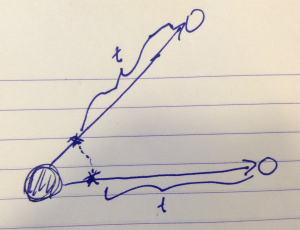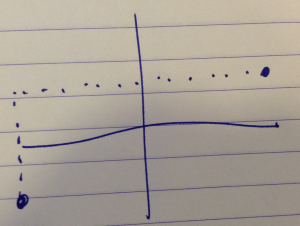[Click here for a PDF of this post with nicer formatting]
[1] pr. 3.9 poses the problem to determine the total rotation angle for a set of Euler rotations given by
\begin{equation}\label{eqn:eulerAngleRotationAngleAndNormal:20}
\mathcal{D}^{1/2}(\alpha, \beta, \gamma)
=
\begin{bmatrix}
e^{-i(\alpha+\gamma)/2} \cos \frac{\beta}{2} & -e^{-i(\alpha-\gamma)/2} \sin \frac{\beta}{2} \\
e^{i(\alpha-\gamma)/2} \sin \frac{\beta}{2} & e^{i(\alpha+\gamma)/2} \cos \frac{\beta}{2}
\end{bmatrix}.
\end{equation}
Compare this to the matrix for a rotation (again double sided) about a normal, given by
\begin{equation}\label{eqn:eulerAngleRotationAngleAndNormal:40}
\mathcal{R}
= e^{-i \Bsigma \cdot \ncap \theta/2}
= \cos \frac{\theta}{2} I – i \Bsigma \cdot \ncap \sin \frac{\theta}{2}.
\end{equation}
With \( \ncap = \lr{ \sin \Theta \cos\Phi, \sin \Theta \sin\Phi, \cos\Theta} \), the normal direction in its Pauli basis is
\begin{equation}\label{eqn:eulerAngleRotationAngleAndNormal:60}
\Bsigma \cdot \ncap
=
\begin{bmatrix}
\cos\Theta & \sin \Theta \cos\Phi – i \sin \Theta \sin\Phi \\
\sin \Theta \cos\Phi + i \sin \Theta \sin\Phi & -\cos\Theta
\end{bmatrix}
=
\begin{bmatrix}
\cos\Theta & \sin \Theta e^{-i \Phi} \\
\sin \Theta e^{i \Phi} & -\cos\Theta
\end{bmatrix},
\end{equation}
so
\begin{equation}\label{eqn:eulerAngleRotationAngleAndNormal:80}
\mathcal{R} =
\begin{bmatrix}
\cos \frac{\theta}{2} -i \sin \frac{\theta}{2} \cos\Theta & -i \sin \Theta e^{-i \Phi} \sin \frac{\theta}{2} \\
-i \sin \Theta e^{i \Phi} \sin \frac{\theta}{2} & \cos \frac{\theta}{2} +i \sin \frac{\theta}{2} \cos\Theta \\
\end{bmatrix}.
\end{equation}
It’s not obvious how to put this into correspondence with the matrix for the Euler rotations. Doing so certainly doesn’t look fun. To solve this problem, let’s go the opposite direction, and put the matrix for the Euler rotations into the form of \ref{eqn:eulerAngleRotationAngleAndNormal:40}.
That is
\begin{equation}\label{eqn:eulerAngleRotationAngleAndNormal:100}
\begin{aligned}
\mathcal{D}^{1/2}(\alpha, \beta, \gamma)
&=
\begin{bmatrix}
e^{-i(\alpha+\gamma)/2} \cos \frac{\beta}{2} & -e^{-i(\alpha-\gamma)/2} \sin \frac{\beta}{2} \\
e^{i(\alpha-\gamma)/2} \sin \frac{\beta}{2} & e^{i(\alpha+\gamma)/2} \cos \frac{\beta}{2}
\end{bmatrix} \\
&=
\begin{bmatrix}
\cos\frac{\alpha+\gamma}{2} \cos \frac{\beta}{2} & – \cos\frac{\alpha-\gamma}{2} \sin \frac{\beta}{2} \\
\cos\frac{\alpha-\gamma}{2} \sin \frac{\beta}{2} & \cos\frac{\alpha+\gamma}{2} \cos \frac{\beta}{2}
\end{bmatrix} \\
&\quad +
i
\begin{bmatrix}
– \sin\frac{\alpha+\gamma}{2} \cos \frac{\beta}{2} & \sin\frac{\alpha-\gamma}{2} \sin \frac{\beta}{2} \\
\sin\frac{\alpha-\gamma}{2} \sin \frac{\beta}{2} & \sin\frac{\alpha+\gamma}{2} \cos \frac{\beta}{2}
\end{bmatrix} \\
&=
\cos\frac{\alpha+\gamma}{2} \cos \frac{\beta}{2}
+ i \sin\frac{\alpha-\gamma}{2} \sin \frac{\beta}{2} \sigma_x
– i \cos\frac{\alpha-\gamma}{2} \sin \frac{\beta}{2} \sigma_y
– i \sin\frac{\alpha+\gamma}{2} \cos \frac{\beta}{2} \sigma_z
\end{aligned},
\end{equation}
This gives us
\begin{equation}\label{eqn:eulerAngleRotationAngleAndNormal:120}
\begin{aligned}
\cos\frac{\theta}{2} &= \cos\frac{\alpha+\gamma}{2} \cos \frac{\beta}{2} \\
\ncap \sin\frac{\theta}{2} &= \lr{ -\sin\frac{\alpha-\gamma}{2} \sin \frac{\beta}{2}, \cos\frac{\alpha-\gamma}{2} \sin \frac{\beta}{2}, \sin\frac{\alpha+\gamma}{2} \cos \frac{\beta}{2} }.
\end{aligned}
\end{equation}
The angle is
\begin{equation}\label{eqn:eulerAngleRotationAngleAndNormal:140}
\theta
= 2 \textrm{arctan} \frac{
\sqrt{\sin^2\frac{\beta}{2} + \sin^2\frac{\alpha+\gamma}{2} \cos^2\frac{\beta}{2}
}
}{\cos\frac{\alpha+\gamma}{2} \cos \frac{\beta}{2}},
\end{equation}
or
\begin{equation}\label{eqn:eulerAngleRotationAngleAndNormal:180}
\boxed{
\theta = 2 \textrm{arctan} \frac{
\sqrt{\tan^2\frac{\beta}{2} + \sin^2\frac{\alpha+\gamma}{2}
}
}{\cos\frac{\alpha+\gamma}{2}
},
}
\end{equation}
and the normal direction is
\begin{equation}\label{eqn:eulerAngleRotationAngleAndNormal:160}
\boxed{
\ncap
=
\inv{\sqrt{1 – \cos^2\frac{\alpha+\gamma}{2} \cos^2\frac{\beta}{2} }}
\lr{ -\sin\frac{\alpha-\gamma}{2} \sin \frac{\beta}{2}, \cos\frac{\alpha-\gamma}{2} \sin \frac{\beta}{2}, \sin\frac{\alpha+\gamma}{2} \cos \frac{\beta}{2} }.
}
\end{equation}
References
[1] Jun John Sakurai and Jim J Napolitano. Modern quantum mechanics. Pearson Higher Ed, 2014.

